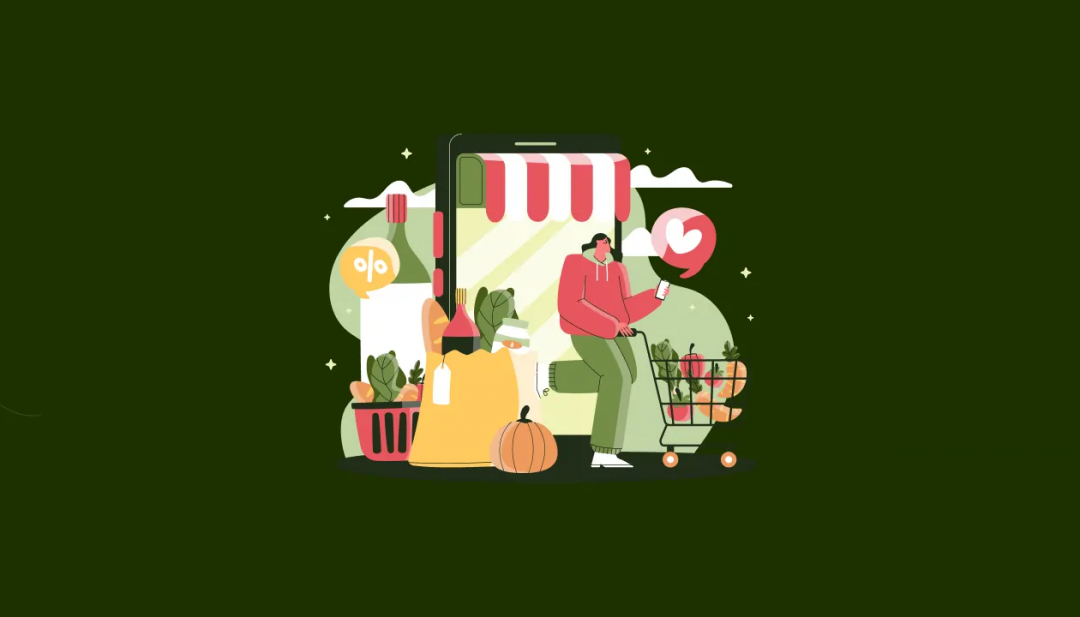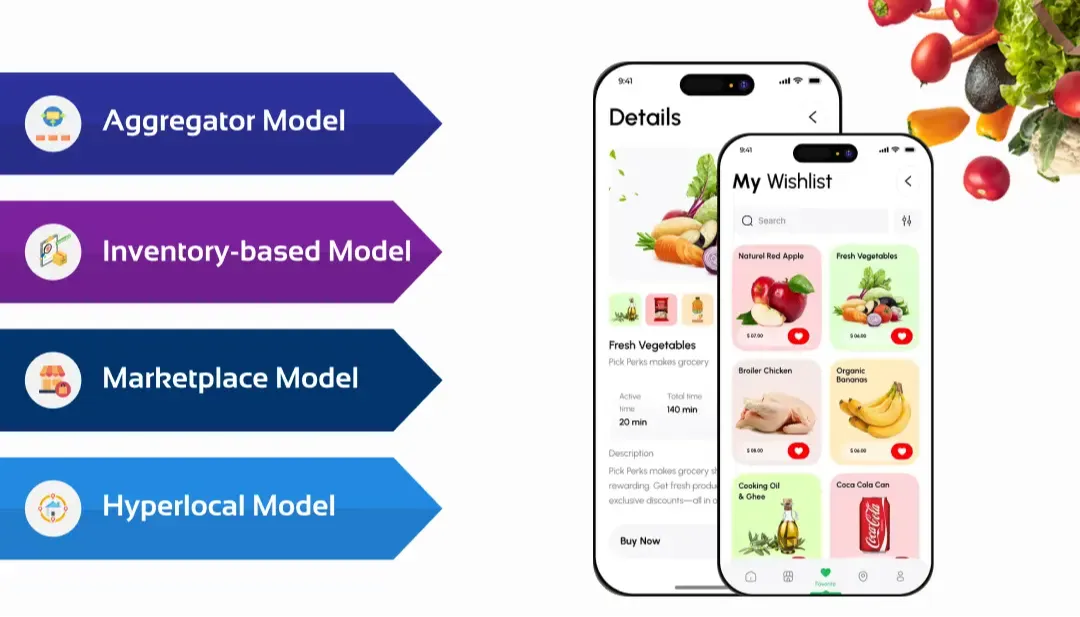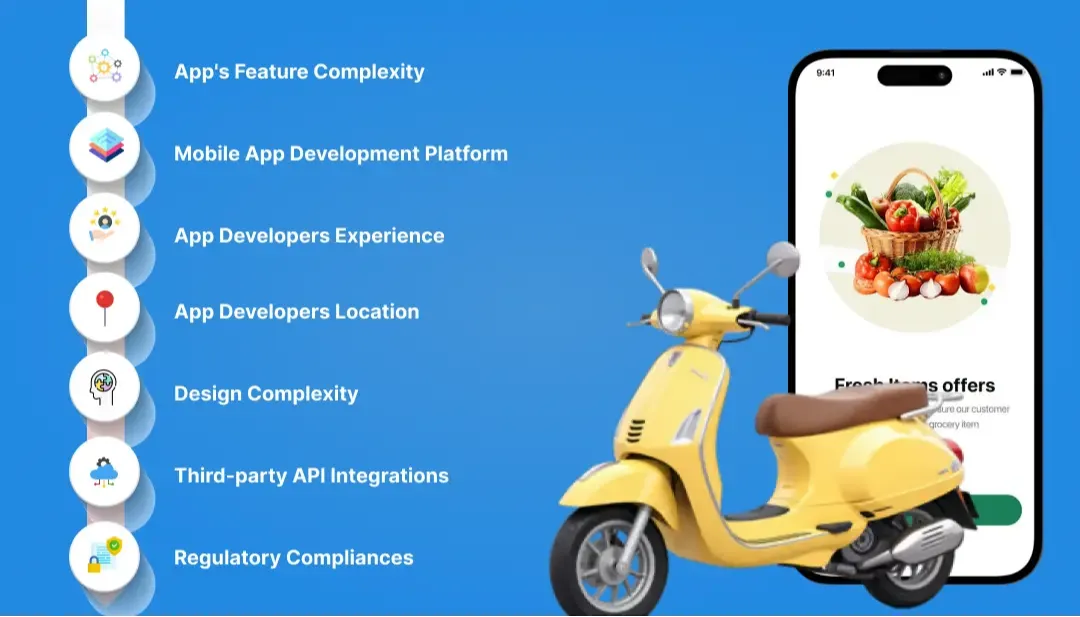Grocery Delivery App Development: Complete Guide For Startups

Lokesh Kumar
Apr 01, 2025

The grocery delivery industry is experiencing an unprecedented transformation, with platforms like Blinkit, BigBasket, and Instacart redefining convenience for millions. As consumer habits shift toward digital-first shopping experiences, the demand for grocery delivery apps is skyrocketing. People now prefer the ease of ordering groceries online and having them delivered to their doorstep in minutes—creating an enormous opportunity for aspiring entrepreneurs.
If you're looking to launch your own grocery delivery startup, now is the perfect time to capitalize on this booming industry. But where do you begin? This guide will walk you through every critical aspect of grocery app development—from understanding the essential features and business models to estimating the cost of developing a grocery app like Blinkit or BigBasket. With a step-by-step approach, this handbook will equip you with the knowledge to build a scalable, feature-rich grocery delivery app and turn your vision into a successful business.
Why Build a Grocery Delivery App?
The online grocery delivery market is experiencing remarkable growth, reflecting a significant shift in consumer shopping habits towards digital platforms. Projections indicate that by 2025, global revenue in the grocery delivery sector will reach approximately $940.96 billion, with an annual growth rate of 10.07% from 2025 to 2029, potentially expanding the market volume to $1.38 trillion by 2029.
Statista
In the United States, the online grocery market is expected to grow from $183.26 billion in 2024 to $715.54 billion by 2033, reflecting a compound annual growth rate (CAGR) of 16.34% between 2025 and 2033.
GlobeNewswire
These statistics underscore the immense potential for startups venturing into grocery app development. The convergence of technological advancements, evolving consumer preferences, and the increasing demand for convenience positions the grocery delivery sector as a highly lucrative and dynamic industry for investment and innovation. Let’s dive deeper into why grocery app development is not just a good idea but a lucrative opportunity for startups:

- Rapid Market Growth – Consumers are shifting towards online grocery shopping.
- High Convenience Factor – Offers doorstep delivery, eliminating store visits.
- Recurring Revenue Model – Subscriptions, commissions, and ad revenues boost profitability.
- Technological Advancements – AI, ML, and IoT enhance user experiences and efficiency.
- Increased Smartphone Usage – Widespread smartphone adoption ensures easy accessibility
Essential Features of a Grocery Delivery App
Creating a successful grocery app requires the right mix of user-friendly features, seamless navigation, and secure transactions. Below are the must-have features categorized by user roles:
1. User Panel (Customer App)
-
Easy Registration & Login – Sign up using social media, email, or phone numbers.
-
Smart Search & Filters – Quickly find products with categories and advanced filtering.
-
Product Details & Reviews – View detailed descriptions, ratings, and customer feedback.
-
Cart & Wishlist – Add products for immediate purchase or future reference.
-
Multiple Payment Options – Integrate UPI, credit/debit cards, wallets, and COD.
-
Order Tracking in Real-time – Track deliveries with live GPS updates.
-
Push Notifications & Alerts – Stay updated on discounts, orders, and recommendations.
-
Subscription & Loyalty Programs – Attract and retain users with offers and rewards.
2. Admin Panel (Management Dashboard)
-
User & Order Management – Track customer orders and preferences.
-
Inventory Control – Manage stock levels and supplier information.
-
Delivery Partner Monitoring – Assign orders, track routes, and optimize deliveries.
-
Analytics & Insights – Generate reports to improve business performance.
-
Customer Support Integration – Provide real-time assistance via chat or call.
3. Delivery Partner Panel (Rider App)
-
Profile Registration – Quick sign-up for delivery agents.
-
Order Notifications – Receive real-time order alerts and delivery instructions.
-
Navigation & Route Optimization – Get optimized routes for quick deliveries.
-
Earnings & Incentives Dashboard – Monitor daily earnings and bonuses.
-
Delivery Status Updates – Update real-time order status for customers.
Advance Features of a Grocery Delivery App
All these mentioned features are standard, and you can find similar features in most grocery apps. But, if you want to make your grocery app development investment worthwhile, then it would be best to include some advanced features as follows:
- Voice-Based Ordering- allows users to create a grocery shopping list and order it via a single voice command.
- Personalized Recommendations- AI & ML-based product recommendation features will help you create high-grade customer satisfaction.
- AR-VR Shopping- it will allow your users to shop for grocery products with an in-store experience virtually.
- Scheduled Delivery Slots- These will help customers get their groceries delivered hassle-free at the desired time.
- Quick Reordering- it can be in two ways: subscription-based or order-history-based to reorder the products.
- Hyperlocal Delivery- customers can choose products online from their nearby stores and get them delivered quickly.
4 Business Models For Grocery Delivery Apps You Can Use!
Choosing the right business model is key to maximizing profitability. Here are four popular approaches:

Aggregator Model
The Aggregator Model acts as a marketplace that connects multiple grocery stores with customers. It functions as a platform where consumers can browse products from various local grocery stores or chains, place their orders, and have them delivered through the app. The primary role of the grocery delivery app is to aggregate the inventory of multiple stores, allowing consumers to shop from different sources within one platform.
Inventory-based Model
In the Inventory-based Model, the grocery delivery business manages its own inventory—either through warehouses or through direct relationships with suppliers. The business purchases groceries in bulk, stores them, and then sells them directly to customers via the app. This model gives the company full control over its inventory, enabling it to offer a more consistent product offering.
Marketplace Model
The Marketplace Model is a hybrid of the Aggregator and Inventory-based models. In this model, the grocery app allows third-party vendors or grocery stores to sell their products directly through the platform. The app acts as a marketplace, facilitating transactions between vendors and consumers but does not hold any inventory. The app generates revenue by charging vendors a commission fee on each sale or by offering paid listings on the platform.
Hyperlocal Model
The Hyperlocal Model focuses on partnerships with local grocery stores in a specific geographic area. This model emphasizes quick delivery times (often within 1-2 hours) by sourcing groceries from local stores and delivering them directly to the customer’s door. The app works closely with local retailers to provide a curated selection of fresh groceries, and often, the delivery is done via a network of independent delivery drivers or third-party logistics companies.
7 Steps To Develop A Grocery Delivery App
Market Research & Competitor Analysis
Conducting thorough market research helps you understand your target audience, identify key competitors, and analyze their strengths and weaknesses. This step involves assessing consumer needs, studying industry trends, and evaluating competitors like Instacart, BigBasket, and Blinkit to find opportunities for differentiation and innovation.
Define Your Unique Selling Proposition (USP)
Your Unique Selling Proposition (USP) sets your grocery delivery app apart from competitors. It could be anything from offering hyperlocal deliveries, integrating AI for personalized shopping experiences, or providing eco-friendly packaging. A clear USP ensures your app addresses a specific market gap and resonates with customers.
Select the Best Grocery App Development Company
Choosing a skilled and experienced grocery app development company is critical for turning your vision into reality. Look for firms with expertise in grocery app development, a solid portfolio, and the ability to create scalable, secure, and user-friendly apps. Check reviews, request proposals, and evaluate their technical capabilities before making a decision.
UI/UX Design & Wireframing
Effective UI/UX design enhances user experience by ensuring the app is intuitive, engaging, and easy to navigate. Wireframing helps visualize the app’s layout and user flow, identifying potential usability issues early. Design focuses on simplicity, clear categories, and smooth navigation to drive customer satisfaction and retention.
App Development & Integration
The development phase involves coding the front-end and back-end of the app, integrating key features like payment systems, real-time tracking, and inventory management. Integration of third-party services such as payment gateways and delivery APIs is also crucial for seamless functionality. The goal is to build a scalable, high-performance app that can handle large volumes of users and transactions.
Testing & Quality Assurance
Comprehensive testing ensures the app performs flawlessly across various devices and operating systems. This includes functional testing, security audits, and load testing to identify bugs, ensure data privacy, and validate performance. Quality assurance helps provide a bug-free, secure, and user-friendly app before its release to the public.
App Deployment & Marketing
After successful testing, the app is deployed on platforms like the App Store or Google Play. Post-launch, strategic marketing is vital for gaining visibility and attracting users. Focus on SEO, social media marketing, paid ads, and influencer partnerships to generate buzz and drive user adoption. Gather feedback for continuous improvement and updates.
Tech Stack Selection for On-Demand Grocery Delivery App Development
Frontend Technologies (Mobile & Web):
- React Native / Flutter: Cross-platform frameworks for building mobile apps on both iOS and Android with a single codebase.
-
Swift (iOS) & Kotlin (Android): Native languages for building high-performance apps on iOS and Android.
-
HTML5, CSS3, JavaScript: For web-based apps, ensuring responsive and interactive designs.
Backend Technologies:
-
Node.js: Fast, scalable, and efficient for real-time apps.
-
Ruby on Rails / Django: For quick development and secure backend management.
-
Java (Spring Boot): For large-scale enterprise apps requiring high stability.
Database:
-
MySQL / PostgreSQL: Reliable relational databases for managing user data, orders, and inventory.
-
MongoDB: NoSQL database for handling large amounts of unstructured data.
Real-Time Communication:
-
Firebase / Socket.io: For real-time updates like order tracking, push notifications, and chat features.
Payment Gateway Integration:
- Stripe / PayPal: Secure and trusted payment systems for processing online transactions.
Cloud Services:
- AWS / Google Cloud / Azure: Scalable cloud platforms for hosting and managing the app infrastructure.
How Much Does It Cost To Develop a Grocery Delivery App?
Now, you might also be interested in knowing how much it costs to develop a grocery app for business or what grocery app development costs. The average cost to develop a grocery app is dependent on multiple factors, such as -

-
App's Feature Complexity
The complexity of features is one of the criteria that influence the app development cost. Complex features lead to more cost.
-
Mobile App Development Platform
Whatever mobile app development platform you choose, the cost will be accordingly. For example- Native Grocery App Development (Android, iOS) and cross-platform app development.
-
App Developers Experience
Developers' experience is also a significant cost-affecting factor. In simplified form, if developers are experienced, then hiring costs will be different compared to junior developers.
-
App Developers Location
Location plays an important role in the developer's hiring and app development costs. For example, the hourly rate of app developers in the USA starts from $100/hr or more, while in countries like India, you can hire experienced grocery app developers at $20/hr onwards.
-
Design Complexity
App designing covers a significant portion of overall app development costs. If it is complex, then the design cost will be higher, and it will affect the total cost.
-
Third-party API Integrations
Third-party API integrations sometimes require more time and licensing fees, which increase the project development cost.
-
Regulatory Compliances
If you develop the grocery app based on compliances like GDPR, CCPA, and PCI DSS, it will also increase the development cost. Similar to API Integration, it increases the project development timeline. On the other hand, there might be chances that you must pay a compliance fee.
Based on all these factors, the grocery app development fee can be decided. However, the approximate cost to develop a grocery app ranges between $10,000-$25,000 for a single platform and a simple version. If you need an advanced grocery app, its cost starts at $30,000 to $49,000+. You can also choose cross-platform grocery app development that will help you target broad audiences.
Monetization Strategies
Monetizing your grocery delivery app is essential for sustaining growth and profitability. Common strategies include:
-
Commission-Based Model: Charge a commission on each order placed through your platform, either from stores or customers.
-
Subscription Model: Offer a subscription service for customers, providing benefits like free delivery, discounts, or priority access to certain products.
-
Advertising: Display ads from third-party brands or local businesses on the app.
-
Premium Listings: Allow grocery stores to pay for premium placement on your platform to increase visibility.
-
Delivery Fee: Charge a delivery fee based on distance, order size, or a flat rate.
The Conclusion
If you are looking to own a startup, grocery app development is one of the most profitable ideas. The only things that matter are how you develop it and who will develop it. The best option is to choose the best option from grocery app development companies. In terms of developing a grocery app, this article can help you as a complete handbook for your startup.
How IMG Global Infotech Can Help You With Grocery App Development Services?
When it comes to hiring a grocery app development company, IMG Global Infotech can be a perfect choice for you. We have extensive expertise in developing cutting-edge grocery apps for startups, grocery stores, and grocery delivery chain businesses. Our team of grocery app developers has in-depth industry knowledge and experience in utilizing the latest tech stack to create seamless online grocery delivery mobile apps. So, if you have any queries, then you can connect with us anytime; it would be pleasant for us to provide you with the best solution.




























